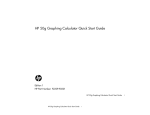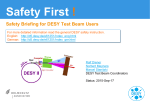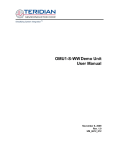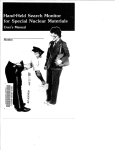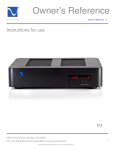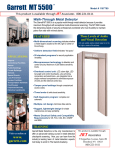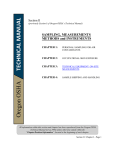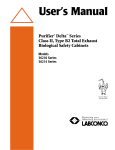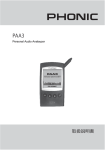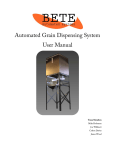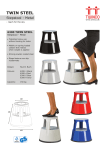Download INTRODUCTION 360° Testing Service has been retained to test an
Transcript
2009 INTRODUCTION 360° Testing Service has been retained to test an “Brand” electric hand dryer, model..., SN 100084, as shown to the right. Using tap water and multiple sets of participants hands, 360° Testing Service performed tests and measurements to confirm product packaging and user manual labeling claims. We also examined the product for defects or other issues. The following presents our findings. Test Protocol The primary intention of our tests was to confirm the product’s claimed hand-drying time of “5 to 7 seconds”. The packaging’s labeling also has claims of : • • • • • • • • • “5 - 7 Seconds drying” “BACTERIA FREE” “ENERGY SAVER” “ENVIRONMENT FRIENDLY” “DIGITAL TIMER” “EASY INSTALL” “FULLY AUTOMATIC” “WORLD’S FASTEST HAND DRYER” “ECHO FRIENDLY product” See the photo below. 360° Testing Service • 470 Nepperhan Ave. • Yonkers, New York 10701 • Toll-Free (877) 380-9545 Page 1 of 16 Features and Exhaust Air Velocity Measurements A “Usage and Instruction” manual was provided with the unit, as well as hardware with which to mount the unit on a wall. The user’s manual is printed only in English, and contains no manufacturer name or contact information. Initial impressions of the user’s manual is that it is very comprehensive and easy to understand. However, we did note that although a switch panel is illustrated in the user’s manual, the manual does not provide any actual explanation of the switches on the panel (see photos). The “HOT” switch turns on and off the internal air warming heater, while the “SPEED” switch provides two air speed options. However, we were unable to measure any difference in the air speed when the “SPEED” switch was set to H or L; nor could we hear any noticeable change in the blower speed. The “SPEED” switch did not appear to do anything at all. The photo to the right shows the air speed and air temperature being measured with a precision Extech AN100 ThermoAnemometer. The exhaust outlets on the opposite side from the anemometer were sealed off with duct tape while the anemometer-temperature sensor were held in the exhaust air stream of the other side. The peak exhaust air velocity measured was just over 18 meters per second, but there was imperfect coupling of the anemometer vane sensor to the actual air stream since there are four sets of ducts within the dryer’s hand cavity. The peak temperature measured by the anemometer was 108.9° Fahrenheit, but thermocouples inserted into the exhaust openings showed that the temperature just inside the small openings is as high as 122° F. The manual does not give the temperature specification, but does list the “injection speed”, which is evidently the exhaust air velocity, as 95 to 102 meters per second, which is 213 miles per hour, somewhat higher than most gas-powered portable leaf blowers. 360° Testing Service • 470 Nepperhan Ave. • Yonkers, New York 10701 • Toll-Free (877) 380-9545 Page 2 of 16 In an effort to reconcile our low air speed measurement, we set up the anemometer to measure the air inlet speed at the bottom of the hand dryer; see the following photo. The flaps were sealed on a small cardboard box which was then taped securely to the bottom of the hand dryer. Holes were cut in the box: one matching the rectangular air inlet of the hand dryer, the other matching the anemometer’s vane sensor. The unit was laid on its side so that air could freely enter the bottom through the anemometer vane sensor. The unit was then started while the anemometer reading was taken. The maximum inlet air velocity measured was about 12 meters per second. To confirm that the box was not severely limiting air intake, we also measured the exhaust velocity with the box taped to the bottom of the hand dryer; we measured a peak exhaust velocity of about 16 meters per second, close to our prior measurement without the box. We then removed the box and re-measured the exhaust velocity, finding it to peak at about 18 meters per second. This showed that the small opening for the anemometer did, indeed, at least slightly restrict the air intake. However, the measured peak is still far below the value published in the user’s manual of 95 to 102 meters per second. Measurements of Hand-Drying Time We performed tests over a time period of, first, 7 seconds, and then the full 25 seconds over which the hand dryer will operate before it “times out” and stops automatically. (Note: the bottom of page 2 of the user’s manual states the time-out period is 30 seconds; but 25 seconds is stated in the last row of the troubleshooting table on page 6; we measured the time-out period to be about 25 seconds). Seven (7) seconds was chosen as that is the time period on the packaging label (“5 - 7 seconds”). When we found that 7 seconds was consistently insufficient to dry hands, then we performed identical tests except that we allowed the hand dryer to time-out (25 seconds) before the subject placed their hands on moisture-sensitive paper. We set up the hand dryer on a stepstool so that the drying cavity was at a convenient height for most adults. A plastic container holding ordinary tap water was provided into which test subjects dipped their hands. They then gently shook excess water off their hands for several seconds before placing them into the hand dryer’s drying cavity. The sequence of photos on the next page illustrate our hand-drying test protocol. During the 7-second tests, they slowly withdrew their hands as per the instructions on the first page of the user’s manual, and then placed them palm-down onto a sheet of moisture-sensitive paper. They lifted their hands, and we photographed the paper, which showed how much moisture still remained on the palm-side of their hands and had been transferred to the paper. After this photo was taken, the subjects then used the paper as a towel, thoroughly wiping the remaining moisture from their hands. The paper was then straightened out and photographed again to show how much more moisture had been transferred from the subject’s hands to the paper. 360° Testing Service • 470 Nepperhan Ave. • Yonkers, New York 10701 • Toll-Free (877) 380-9545 Page 3 of 16 For the full-time drying test (25 seconds, until the hand dryer “timed out”), the same procedure was followed except the subjects kept their hands within the drying cavity, rotating them slightly to allow the heated air to dry their hands. They then placed their hands on another dry sheet of moisture-sensitive paper, the paper was photographed, then they again used the paper as if it were a paper towel and thoroughly dried their hands on the paper. The paper was then straightened and photographed once again. The following photo sequence shows this process in detail. The photos on the following pages show how much moisture was transferred from the hands of three subjects onto a dry sheet of moisture-sensitive paper. Each subject performed the test for each time period (7 seconds or 25 seconds) at least twice, to ensure repeatability. 360° Testing Service • 470 Nepperhan Ave. • Yonkers, New York 10701 • Toll-Free (877) 380-9545 Page 4 of 16 360° Testing Service • 470 Nepperhan Ave. • Yonkers, New York 10701 • Toll-Free (877) 380-9545 Page 5 of 16 360° Testing Service • 470 Nepperhan Ave. • Yonkers, New York 10701 • Toll-Free (877) 380-9545 Page 6 of 16 360° Testing Service • 470 Nepperhan Ave. • Yonkers, New York 10701 • Toll-Free (877) 380-9545 Page 7 of 16 360° Testing Service • 470 Nepperhan Ave. • Yonkers, New York 10701 • Toll-Free (877) 380-9545 Page 8 of 16 360° Testing Service • 470 Nepperhan Ave. • Yonkers, New York 10701 • Toll-Free (877) 380-9545 Page 9 of 16 It is evident that the hands of none of the tested subjects were completely dry even after the “time-out” period of 25 seconds had expired. In each case, after just 7 seconds, the hands of all subjects were very damp, sometimes with droplets of water still visible on the hands. After 25 seconds, while hands were still somewhat damp, moisture primarily remained in between fingers while exposed areas of the hands were dry or mainly-dry. Electric Hand Dryer Comparison Tests We compared some measurable characteristics of the Brand hand dryer with several other hand dryers, as shown in the table below. Manufacturer Brand American Dryer Inc. World Dryer Model Brand Model Global Dryer, GX1-M XA5 Dry Time, Seconds 25 - 30 55 - 57 25 - 30 Exhaust Air Velocity, Meters/Sec. ~18 ~15 ~26 Exhaust Air Temp. °F ~121 ~127 ~124 Sound Pressure Level (SPL), dB (A-weighting) 85 70 79 360° Testing Service • 470 Nepperhan Ave. • Yonkers, New York 10701 • Toll-Free (877) 380-9545 Page 10 of 16 Global Dryer ™ by American Dryer, Inc., model GX1-M World® Dryer, model XA5 The Sound Pressure Level (SPL) was measured using a Phonic PAA3 sound pressure meter, set to A-weighting. The SPL meter was held at head height with the directional microphone pointing toward the dryer, to simulate the SPL that a human ear would hear. Electrical Power Consumption Using a precision Amprobe model ACD-51HP power quality clamp-on digital meter, and a Watt’s-Up PRO digital power analyzer, we measured the power consumption of the Brand as shown in the table below. Condition Standby Running w/Heater Running w/o Heater Watts 3.7 - 3.8 1751 795 Power From Usage Manual -------2000 900 VoltAmps 4 1983 1250 VAC 126.2 113.2 121.3 Amps. ~ 0.03 18.1 10.35 Amps. From Usage Manual -------15 6 Power Factor (PF) 1 0.88 0.63 360° Testing Service • 470 Nepperhan Ave. • Yonkers, New York 10701 • Toll-Free (877) 380-9545 Page 11 of 16 “Standby” is when the dryer is idling, and not running. The HEAT switch was turned on or off for the “Running w/Heater” and “Running w/o Heater” measurements. Note that when the heater is not running, the Power Factor of the unit becomes quite unfavorable (1.0:1 is desired) and the apparent-power (Volt-Amps) becomes very high compared to the watts consumed. Also note that when in standby, the Brand hand dryer continuously draws just under 4-watts. This standby power consumption is in contrast to the claims of “environmentally friendly”—since that power does no work, it is essentially wasted. Over a year’s time, an idling Brand hand dryer will consume over 35 kilowatt-hours of electricity. “Undocumented Feature” The “Usage and Installation Manual,” twice, states that an indicator light that is on the top of the unit, labeled “CHECK” on the unit, but labeled “Self-Check” in the manual, should operate in this fashion (quotes are from the bottom of page 4 and the bottom of page 11, respectively): “Self-check indicator When a malfunction or error occurs, the self-check indicator on the right side will either light up or flash. Turn off the power switch, wait about 40 seconds until all the indicators go off, then turn on the power switch. If the indicator still lights up or flashes, turn off the power, disconnect the unit from the socket, and contact your dealer immediately.” “* If the self-check indicator in the display lights or is flashing, turn off the power switch off, and turn the power back on when all the indicators go off (after 40 seconds)” We found that when the unit is idling, the self-check indicator light is off. However, when hands are inserted into the drying cavity and the dryer is activated, the indicator illuminates continuously until the hands are removed. It appears to be indicating that the unit is activated, rather than that there is a fault. This appears to be an “undocumented feature” and not an indication of trouble when the unit has been activated. Cosmetic Issues The Brand hand dryer has a plastic case that appears to have been painted. The paint does not fully cover all exposed edges, as seen in the photos on the following page. The power, “HOT” and “SPEED” switches are concealed behind a small plastic door that readily swings open, exposing those switches. There is no way to lock that door to prevent unauthorized access. The door also does not fully fit properly. 360° Testing Service • 470 Nepperhan Ave. • Yonkers, New York 10701 • Toll-Free (877) 380-9545 Page 12 of 16 Above: The door does not fit properly. The exposed vertical edge is unpainted. Top edge facing the user is unpainted. Horizontal edge under the display panel is unpainted. 360° Testing Service • 470 Nepperhan Ave. • Yonkers, New York 10701 • Toll-Free (877) 380-9545 Page 13 of 16 Packaging Issue The Brand Model hand dryer is packaged into a large, illustrated cardboard box as seen in the photo to the right. The hand dryer is shipped laying down in a strong shipping carton, supported and padded by two formed Styrofoam blocks on each side. While it is easy to find a hand-grip at the top of the unit, the bottom side, with the fragile air cleaner element, presents a problem, as seen in the following sequence of photos. The bottom of the hand dryer has a fragile air cleaner element that is easy to tear or break. To remove the packed hand dryer from the box, it is necessary to reach down to the bottom of the box, around to the back side, and lift straight out. There is no indication that the air cleaner element should not be touched during this unpacking operation. 360° Testing Service • 470 Nepperhan Ave. • Yonkers, New York 10701 • Toll-Free (877) 380-9545 Page 14 of 16 Here, it is clear that the air cleaner element is susceptible to damage while attempting to find somewhere to lift the unit from the shipping carton. In the right photo, note how the air cleaner element is being inadvertently bent in by the hand attempting to find a grip on the back side of the hand dryer. Keep in mind that the unit comes wrapped within a plastic bag that is folded over the air cleaner element, thus concealing it (see the photo on the previous page, bottom left). Again, it is clear that the air cleaner element is in danger of being damaged during removal of the hand dryer from the box. It appears that the best way to remove the hand dryer is to turn the box upside down, and then lift the box off, leaving the hand dryer laying on the surface within the two Styrofoam blocks. 360° Testing Service • 470 Nepperhan Ave. • Yonkers, New York 10701 • Toll-Free (877) 380-9545 Page 15 of 16 Conclusions In testing the Brand electric hand dryer did not dry hands within 5 to 7 seconds as claimed. Test subjects each required at least 25-seconds for their hands to be fully dry. After-7 seconds, the hands of all participants were still damp or visibly wet. The exhaust air velocity appeared to be about one-fifth of the claim published within the user’s manual. However, because the SPEED switch did not appear to work (we could not measure or hear any difference between “LOW” and “HIGH”), we are unable to determine whether the unit might be “stuck” in LOW speed, which might be why it takes so much longer to dry hands than the published claims. In addition, the Brand unit also appears to draw considerably more electric power than specified in the user’s manual, over 18 amperes compared to a claimed 15 amperes. This amount of power is what might be expected if the unit were actually running at HIGH speed, however; and so we strongly suspect that throughout our tests, it was actually in HIGH speed rather than low. The noise level of the Brand is considerably higher than two other electric hand dryers against which we drew comparison; but one competitive dryer (Global Dryer, GX1-M) also required about twice as long to fully dry hands. Unlike the competitive dryers noted and examined above, the case of the Brand dryer is plastic. The Brand’s plastic case exhibited numbers of cosmetic flaws including lack of paint on exposed edges, and somewhat poor fit of certain plastic pieces. The Brand dryer is unique in that it is the only electric hand dryer we found that requires a water tank to collect the water blown off of hands. The design of the unit is such that such a tank is actually required, compared to more-standard hand dryers, because other units simply blow the water onto the floor from a single exhaust outlet. The Brand, however, has two opposing exhaust outlets, between which the hands are placed so that both sides are dried simultaneously. Thus, water would be blown downward into the unit were there not such a water-collection tank. 360° Testing Service • 470 Nepperhan Ave. • Yonkers, New York 10701 • Toll-Free (877) 380-9545 Page 16 of 16
















